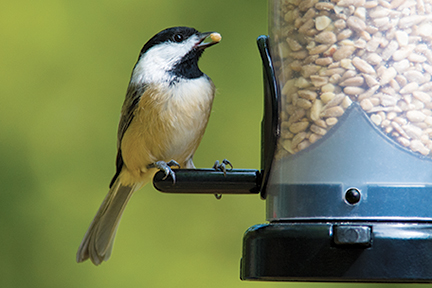
The Gifts Birds Give Us
BY REBECCA (RJ) WARREN
Because we are in the thick of the season when gift-giving is at its peak (and also for all of us who have ever joked about adding a tip jar to our bird feeding station), in this newsletter we will look at some gifts that birds give to us.
TREES
If you offer peanuts in shell in your bird feeders you can attest to how attuned the Blue jays are to when you refill and how quickly they can show up and begin to empty that feeder. The live camera feed from Cornell Lab of Ornithology plays in store and we have been known to make friendly bets on what time it will be when the Blue jays deplete the peanuts in Cornell’s just-filled feeder (they use the Wild Birds Unlimited Peanut Hut). Those who bet on a time an hour or less away will nearly always win.
Blue jays carry peanuts away and cache them for later retrieval like they do tree nuts. They have been observed depositing acorns within a few yards of one another, then covering them with leaf litter. If the bird forgets the exact location of an acorn, or doesn’t consume the full cache because of a mild winter, or, sadly, dies, that acorn may grow into a tree.
In his article about Blue jays for Audobon.org, Les Line writes about a study that reported that “91% of the caching sites were on suburban tracts or bare soil.” In fact, Line writes, “Blue jays are the keystone species in restoring stands of oaks and other mast trees in today’s fragmented landscape, where forest patches are isolated by farms, suburban sprawl, and highway construction.”
HOT PEPPERS
When you are giving your spice level for your order at your favorite Thai restaurant, watching Bill Murray field interview questions on Hot Ones, or picking up a hot sauce sampler as a gift for your gourmand cousin, you can thank the birds. If you are using one of Wild Birds Unlimited’s hot pepper foods, such as Flaming Hot Feast, you’ve noticed birds are not deterred by the habanero oil it is treated with, while squirrels are more reluctant to take a big bite of the fiery food.
Beyond our feeders, because birds are not susceptible to the pain from the capsaicin in hot peppers, they will ingest the fruit and therefore seeds from a hot pepper plant that a mammal, who can sense the pain, might avoid. The seeds they then excrete grow into new pepper plants. And since birds may cover far more ground than a mammal, they are responsible for the propagation of that plant over a greater distance.
ACTUAL…GIFTS?
Have you ever found a trinket in your tray feeder? Dr. John Marzluff, a conservation ecologist at the University of Washington, calls crows’ occasional behavior of leaving keys, earrings, stones, and bones in or near feeders “gifting.” In her article for Audobon.org, Jillian Mock writes that while we cannot assume this behavior indicates “some sort of reciprocity,” it is incredible to consider that the crow may have learned that a bauble left behind (perhaps dropped from a beak preoccupied with food), resulted in an excited human refilling a feeder, perhaps adding even greater quantities of food. Marzluff published an article in Psychology Today that asked “Could Wild Birds Reciprocate Our Kind Actions?” Certainly birds bring us a number of benefits, as well as a great deal of joy every day, which many of us consider a beautiful gift.

